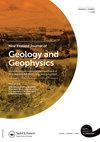A new early Miocene archaic dolphin (Odontoceti, Cetacea) from New Zealand, and brain evolution of the Odontoceti
IF 1.9
4区 地球科学
Q1 GEOLOGY
New Zealand Journal of Geology and Geophysics
Pub Date : 2022-01-17
DOI:10.1080/00288306.2021.2021956
引用次数: 1
Abstract
ABSTRACT The major increase in cetacean brain size happened in the middle Miocene, about 15 million years ago, and involved the modern oceanic dolphin lineage Delphinoidea. In this paper, we describe a new specimen of an archaic dolphin, aff. Prosqualodon davidis, from the Gee Greensand, near Oamaru, New Zealand. The specimen is from the early Miocene, approximately 23–19–18 Ma, and includes an incomplete cranium, endocast, teeth, and some postcranial elements. Comparison of the median sulcus among previously reported endocasts and brains of the Cetacea suggests that the cerebrum was expanded incipiently in the Odontoceti from the early Miocene in the Eurhinodelphinidae + Delphinoidea lineage. Conversely, the olfactory fossa has been reduced in Odontoceti, and completely lost in at least two clades (Delphinoidea and Platanista gangetica), because olfaction was most likely no longer an essential sense for animals spending their life in water. Reduction and loss of the olfactory fossa saved energy, which may be related to the expansion of the cerebrum and cortex in an Odontoceti lineage that led to modern oceanic dolphins. The early Miocene appears to have been a transitional period for archaic and modern-type odontocetes, which were possibly and partly separated by these differences.新西兰新发现的早中新世古海豚(齿鲸目,鲸目)及齿鲸目脑进化
摘要鲸目动物大脑大小的主要增长发生在中新世中期,约1500万年前,涉及现代海洋海豚谱系海豚总科。在这篇论文中,我们描述了一种古老海豚的新标本aff。Prosquarodon davidis,来自新西兰奥马鲁附近的Gee Greensand。该标本来自中新世早期,约23–19–18 Ma,包括不完整的颅骨、内壳、牙齿和一些颅后元素。对先前报道的鲸目动物的内壳和大脑的正中沟的比较表明,从中新世早期开始,Eurhinodelphinidae的Odontoceti大脑开始扩张 + Delphinoidea谱系。相反,Odontoceti的嗅觉窝已经减少,并且在至少两个分支(Delphinoidea和Platanista gangetica)中完全消失,因为嗅觉很可能不再是在水中生活的动物的基本感觉。嗅觉窝的减少和丧失节省了能量,这可能与Odontoceti谱系中大脑和皮层的扩张有关,这导致了现代海洋海豚。中新世早期似乎是古代和现代类型牙冠的过渡时期,它们可能并部分地因这些差异而分离。
本文章由计算机程序翻译,如有差异,请以英文原文为准。
求助全文
约1分钟内获得全文
求助全文
来源期刊
CiteScore
5.10
自引率
27.30%
发文量
34
审稿时长
>12 weeks
期刊介绍:
Aims: New Zealand is well respected for its growing research activity in the geosciences, particularly in circum-Pacific earth science. The New Zealand Journal of Geology and Geophysics plays an important role in disseminating field-based, experimental, and theoretical research to geoscientists with interests both within and beyond the circum-Pacific. Scope of submissions: The New Zealand Journal of Geology and Geophysics publishes original research papers, review papers, short communications and letters. We welcome submissions on all aspects of the earth sciences relevant to New Zealand, the Pacific Rim, and Antarctica. The subject matter includes geology, geophysics, physical geography and pedology.

 求助内容:
求助内容: 应助结果提醒方式:
应助结果提醒方式:


